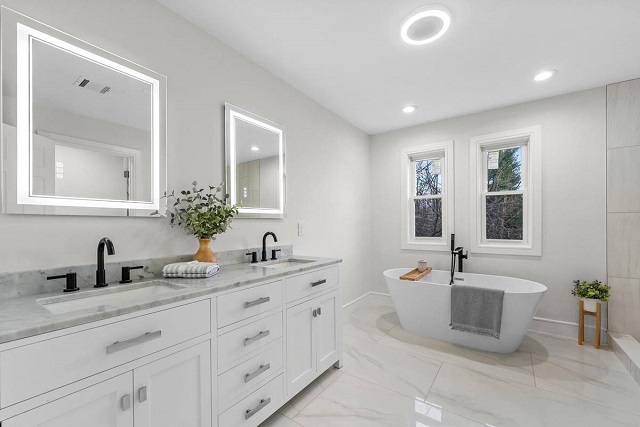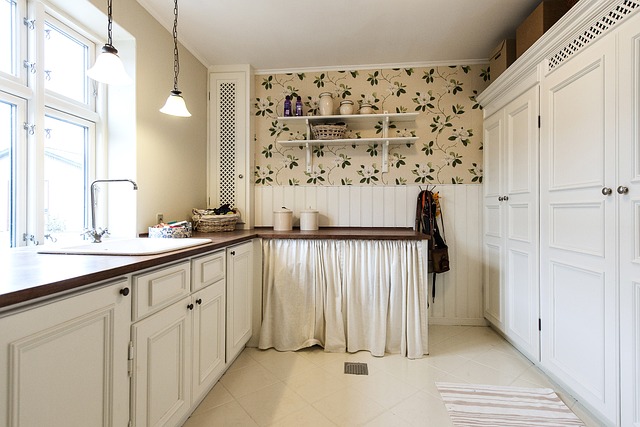Table of Contents
Preparation before Painting kitchen cabinets
Before plunge into the painting kitchen cabinets, it is vital to ensure that all necessary preparations have been diligently carried out. The first step is to thoroughly inspect the cabinets for any imperfections that may require attention before painting. This could include dents, scratches, or uneven surfaces that need to be addressed to achieve a smooth and flawless finish. Additionally, it is imperative to clean the cabinets meticulously to remove any dirt, grease, or residue that could hinder the adhesion of the paint. A clean and well-prepared surface is essential for the paint to adhere properly and ensure a long-lasting finish.
Once the cabinets have been inspected and cleaned, it is important to protect the surrounding areas from any potential paint splatter or spills. Covering floors, countertops, and any nearby furniture with drop cloths or plastic sheeting will prevent accidental damage and make cleanup much easier. Furthermore, removing any cabinet hardware such as handles or knobs before painting will ensure a more even and professional-looking finish. Taking the time to prepare adequately before painting will result in a high-quality and durable finish that will enhance the appearance of the cabinets for years to come.
Selecting the right paint color
When starting a cabinet painting project, the choice of paint color is crucial. The selected hue sets the tone for the entire room, enhancing its aesthetic appeal and creating a cohesive look. Professional painters recommend selecting a paint color that complements the existing decor while also injecting a fresh vibe into the space. Consider the room’s natural light, the color scheme of nearby furniture, and the overall ambiance you wish to achieve. Opting for a timeless neutral shade can provide versatility, allowing for easy updates to the room’s accessories and accents over time.
The painter’s expertise in color selection can greatly impact the final outcome of the cabinet painting project. Consulting with a professional can offer valuable insights into trending color palettes, paint finishes, and techniques that best suit your space. A skilled painter can guide you in choosing a paint color that not only reflects your personal style but also enhances the visual impact of your cabinets. By carefully considering the painter’s recommendations and expertise, you can ensure a successful and visually pleasing transformation of your cabinetry.
Choosing the appropriate primer
When painters are looking to refinish cabinets, selecting the right primer is crucial for a successful outcome. The primer serves as the foundation for the paint to adhere to the surface properly, ensuring a smooth and durable finish. It is important to choose a primer specifically designed for the material of your cabinets, whether they are wood, laminate, or metal, to achieve the best results.
In addition to considering the material of the cabinets, painters should also pay attention to the type of paint they plan to use. Some primers are formulated to work better with certain types of paints, such as oil-based or water-based paints. By selecting a primer that is compatible with the paint you intend to use, you can enhance the adhesion and durability of the final paint job.
Sanding and cleaning the kitchen cabinets
To achieve a flawless finish when repainting your kitchen cabinets, the process of sanding and cleaning the surfaces is crucial. Before applying new paint, it is essential to prepare the cabinet surfaces by sanding them down. This step helps to remove any existing paint or finish, creating a smooth and even base for the new coat of paint. Using sandpaper with a medium grit is recommended to ensure that any imperfections or rough areas are properly addressed. Once the cabinets are sanded down, it is vital to wipe them clean with a damp cloth to remove any dust or debris that may affect the final outcome of the house painting.
After sanding the cabinets, the next step in the house painting process is to thoroughly clean the surfaces to ensure optimal paint adhesion. Using a mild detergent or a solution of water and vinegar, gently scrub the cabinet surfaces to remove any grease, dirt, or other residues that may have accumulated over time. Pay special attention to areas near the stove or sink, as these areas are more prone to grease buildup. Rinse the cabinets with clean water and allow them to dry completely before moving on to the next stage of the painting process.
Removing cabinet hardware
When preparing to paint your kitchen cabinets, it is essential to start by removing the cabinet hardware. This step will ensure a smooth painting process without any obstructions. Carefully unscrew and detach the knobs, handles, hinges, and any other hardware from the cabinet doors and drawers. Place the hardware in labeled bags or containers to keep track of them and prevent misplacement. By taking the time to remove the hardware before painting, you will achieve a professional finish that showcases attention to detail and precision.
If you are unsure about how to safely remove the cabinet hardware or if you are concerned about damaging any components, consider seeking assistance from a reputable painting company. Professional painters have the expertise and tools necessary to efficiently remove the hardware without causing any harm to your cabinets. By entrusting this task to experts, you can ensure that the painting process will proceed smoothly and result in a flawless finish. Remember that proper preparation, such as removing cabinet hardware, is key to achieving professional-looking painted cabinets that will enhance the overall aesthetic of your space.
Protecting surrounding areas
To ensure a clean and professional finish, it is imperative to protect the surrounding areas when painting kitchen cabinets. Prior to beginning the painting process, a painting contractor should take the necessary steps to safeguard floors, walls, countertops, and any other fixtures nearby. This can be achieved by covering these surfaces with protective materials such as drop cloths or plastic sheeting. By doing so, the risk of accidental splatters or spills ruining the surrounding areas will be greatly minimized.
In addition to covering surfaces, painting contractors should also consider taping off areas that are not meant to be painted. Using painter’s tape to outline edges and corners will create crisp lines and prevent any paint from bleeding onto unintended surfaces. This attention to detail not only showcases a professional level of precision but also aids in completing the cabinet painting project with a polished and refined look.
Applying the primer evenly
To ensure a flawless finish and optimal adhesion of paint, it is imperative to apply the primer evenly on the cabinet surface. The application process should be methodical and precise, leaving no room for patchy coverage or dripping paint. Consistency is key when it comes to priming cabinets, as any unevenness may mar the final result and necessitate costly touch-ups by a painting service.
When applying the primer, it is essential to maintain a steady hand and work in controlled strokes to achieve an even distribution of the product. Avoid rushing through this step, as haste can lead to inconsistent coverage and compromise the integrity of the primer. Remember, a well-primed surface is the foundation for a professional finish, so take the time to ensure that every nook and cranny of the cabinets receives an even coat of primer before proceeding to the next step in the painting process.
Allowing primer to dry completely
Once the primer has been applied to the kitchen cabinets, it is imperative to follow the manufacturer’s guidelines regarding drying time. Rushing this crucial step can result in a subpar finish that may not adhere properly. A reputable house painter understands the significance of allowing primer to dry completely before proceeding with the next steps in the painting process. Patience is key in achieving a flawless final result that will stand the test of time.
Furthermore, failure to allow the primer to dry thoroughly can lead to issues such as bubbling, peeling, or uneven coverage when the paint is applied. To ensure the best outcome, it is recommended to wait at least the specified duration for the primer to dry before moving forward. A skilled house painter knows that proper drying time is non-negotiable in achieving a professional and long-lasting finish for your cabinets.
Applying the paint in thin, even coats

When it comes to residential painting projects, applying the paint in thin, even coats is a crucial step to achieve a professional-looking finish. By ensuring that the paint is applied evenly, you can avoid streaks, drips, and an uneven appearance on your cabinets. This method also helps the paint to dry more smoothly and reduces the likelihood of any imperfections in the final result.
One key tip to keep in mind when applying paint in thin, even coats is to work methodically and patiently. Rushing through this step can lead to a sloppy finish and may require additional touch-ups later on. By taking your time and applying the paint with precision, you can create a beautifully painted surface that enhances the overall look of your cabinets.
Using a high-quality brush or roller
To achieve a flawless finish when painting kitchen cabinets, it is imperative to invest in high-quality brushes or rollers. As a commercial painter, utilizing premium tools not only ensures a smoother application but also enhances the overall durability and aesthetic appeal of the painted surface. Cheaper quality brushes or rollers may result in streaks, brush marks, or an uneven distribution of paint, compromising the final outcome.
When selecting a brush or roller for painting kitchen cabinets, opt for one specifically designed for the type of paint being used and the surface area to be covered. High-quality tools with fine bristles or nap help in achieving a professional finish by evenly dispersing the paint and minimizing the risk of visible brush strokes or roller marks. Remember, a well-chosen brush or roller can make a substantial difference in the overall quality and longevity of the painted cabinets, showcasing the expertise and attention to detail characteristic of a seasoned commercial painter.
• It is recommended to invest in high-quality brushes or rollers for painting cabinets
• Premium tools ensure a smoother application and enhance durability and aesthetic appeal
• Cheaper quality brushes or rollers may result in streaks, brush marks, or uneven paint distribution
• Select a brush or roller designed for the type of paint and surface area to be covered
• High-quality tools with fine bristles help achieve a professional finish with minimal visible strokes or marks
Allowing paint to dry between coats
To achieve a flawless finish on your painted kitchen cabinets, it is crucial to allow the paint to dry thoroughly between coats. Rushing through this step can lead to an uneven application and result in a subpar final appearance. Professional residential painters understand the importance of patience during the drying process to ensure a smooth and consistent finish.
Applying a second coat of paint before the first coat has completely dried can cause streaks, drips, and an overall unprofessional look. By allowing each coat to dry fully before applying the next one, you will achieve a professional and long-lasting result on your cabinets. Remember, patience is key when it comes to painting projects, and allowing proper drying time between coats is essential for a successful outcome.
Adding a second coat if necessary
When assessing the completion of the initial coat of paint on your cabinets, meticulous observation is pivotal before deciding whether a second coat is imperative. Key indicators signaling the need for an additional coat include uneven coverage, visible brush strokes or roller marks, and an overall lack of depth in color saturation. In order to achieve a flawless and professional finish, it is paramount to rectify any imperfections or inconsistencies by proceeding with the application of a second layer of paint.
Upon recognizing the necessity for an additional coat, ensure the first layer has dried sufficiently based on the manufacturer’s recommended timeframe. Before applying the second coat, lightly sand the surface to eliminate any rough spots or bumps that may have formed during the drying process. By meticulously adhering to this preparatory step, you are effectively priming the surface for the subsequent coat of paint, thereby guaranteeing a smooth and refined final result. Moreover, proceeding with meticulous attention to detail during the second coat’s application is vital in achieving a seamless and professional appearance for your painted cabinets.
Reattaching kitchen cabinets hardware
When reattaching cabinet hardware, it is essential to ensure that each piece is securely fastened to the cabinet surface. Use a screwdriver or drill to carefully screw in the hardware, making sure it is snug and does not wiggle. This will prevent any future loosening or damage to the cabinets. Remember to align the hardware properly according to the pre-existing holes or markings on the cabinets to maintain a uniform and polished look.
Once all the hardware is reattached, give each piece a gentle tug to confirm its stability. Any loose hardware should be tightened immediately to prevent accidents or further damage. A final inspection of the cabinets should be conducted to ensure that all knobs, handles, or hinges are firmly in place. Lastly, wipe down the hardware with a clean cloth to remove any fingerprints or smudges, leaving your cabinets looking professional and clean.
Sealing the kitchen cabinets for protection
To ensure long-lasting protection and durability of your newly painted kitchen cabinets, it is essential to apply a sealing coat once the paint has fully dried. The sealing process involves using a clear topcoat or sealant specifically designed for painted surfaces. This final step not only adds an extra layer of protection against daily wear and tear but also helps in maintaining the vibrancy of the paint color over time.
When selecting a sealant for your cabinets, opt for a product that is compatible with the type of paint used and offers resistance to moisture, heat, and stains. It is recommended to apply the sealant in thin, even coats using a high-quality brush or roller to achieve a smooth and uniform finish. Allow each coat to dry completely before adding additional layers to ensure maximum protection and longevity of your painted cabinets.
Maintaining and cleaning painted kitchen cabinets
To uphold the pristine appearance of your newly painted kitchen cabinets, it is imperative to implement regular maintenance practices. Routine dusting with a soft microfiber cloth can prevent the accumulation of dirt and grime on the cabinet surfaces. For tougher stains or spills, utilize a mild detergent solution and gently wipe the affected area to maintain the integrity of the paint finish. Remember to avoid harsh chemicals or abrasive cleaners that could potentially damage the painted surface.
In addition to cleaning, inspect your cabinets periodically for any signs of wear or chipping. Promptly addressing any areas of concern by touching up the paint can prevent further deterioration and preserve the overall aesthetic appeal of your cabinets. Furthermore, consider applying a protective top coat to enhance the durability of the paint finish and shield the cabinets from everyday wear and tear. Regular maintenance and care are essential in prolonging the longevity of your painted cabinets and ensuring their continued visual allure.



